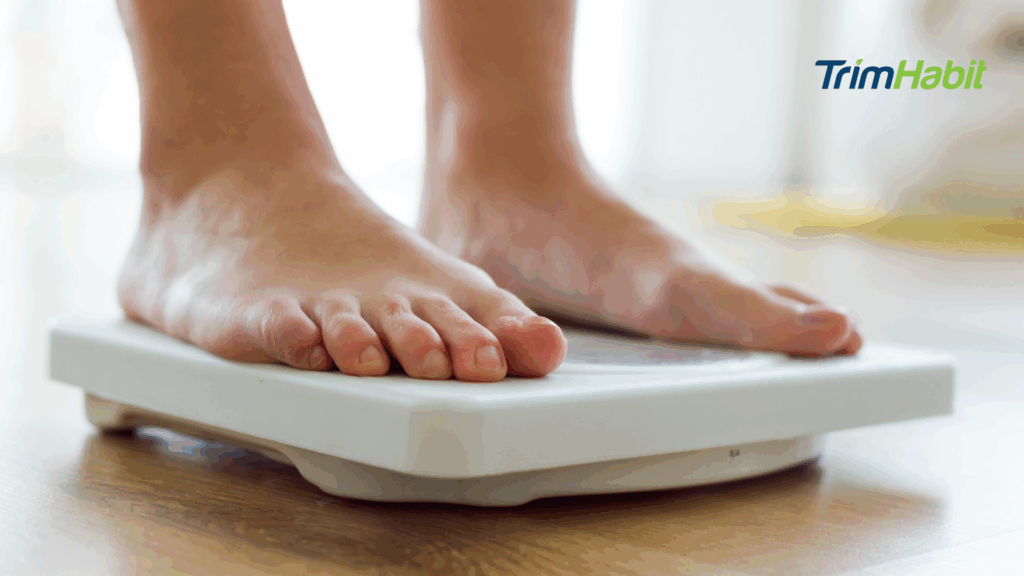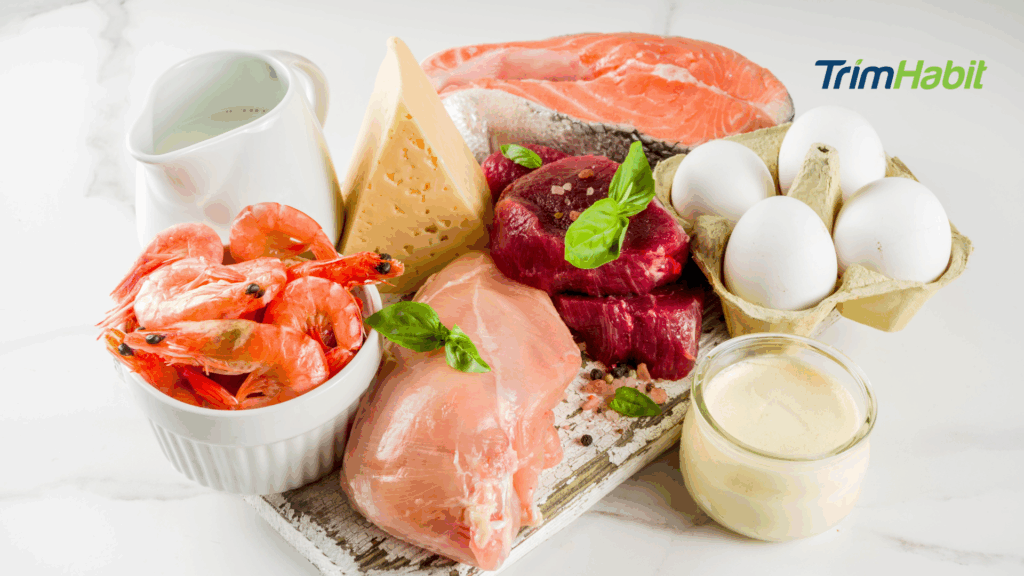When you start semaglutide, eating enough can feel like a challenge. The medication helps manage appetite, slows digestion, and changes how your body processes food. That’s great for managing weight, but it can make it harder to eat enough protein.
Learning how to hit your protein goals on semaglutide without feeling stuffed is key to keeping your body strong, supporting your metabolism, and feeling good each day.
Protein helps maintain lean muscle mass, stabilizes blood sugar, and prevents your metabolism from slowing down during your weight loss journey1,2,3. The problem is that appetite can drop sharply when taking semaglutide, and eating high-protein foods may feel heavy or overwhelming.
Fortunately, there are simple, evidence-based ways to meet your needs without discomfort or overfilling yourself.
Why Protein Is Crucial On Semaglutide
Protein is the building block of your muscles, tissues, and enzymes. When your body gets less energy from food, it naturally looks for other sources, and muscle can become one of them. That’s why maintaining a high protein intake is crucial when trying to lose weight. You want your body to use stored fat for energy, not muscle tissue.
Semaglutide affects body weight through its impact on hormones that control appetite and digestion. Its GLP-1 (glucagon-like peptide-1) active ingredient helps you feel satisfied sooner, reduces cravings, and slows how quickly food leaves your stomach4. These effects help with weight loss, but they can also make it harder to eat enough to preserve lean muscle mass.
If your protein drops too low, your muscle mass may decline, which can lead to weakness, slower metabolism, and a plateau in fat loss. Protein isn’t just about body composition; it also supports your immune system and helps regulate blood sugar. Getting the right balance will protect your strength during semaglutide treatment and make your progress more sustainable.
Finding The Right Protein Amount For You
Before you plan your meals, you need to understand how much protein your body actually needs. The right amount depends on your body weight, activity level, and how much lean tissue you want to maintain. Most research suggests aiming for about 0.8 to 0.9 grams of protein per pound of lean body mass if you want to maintain muscle while losing fat5.
These numbers translate to personalized protein targets. Think of them as flexible goals that help you stay nourished without feeling pressured to overeat. Talk to your healthcare provider, registered dietitian, or even an obesity medicine specialist to calculate what’s realistic for you. They can help you set protein goals that fit your schedule, hunger levels, and lifestyle.
Distributing your protein evenly throughout the day helps a lot. Eating frequent meals gives your body steady access to amino acids and keeps you from feeling overly full. Smaller portions of high-quality protein spread out can be easier to handle than large servings at once.
Smart Protein Sources That Feel Light But Satisfying
The type of food you eat matters as much as the amount. Heavy meats and dense foods can make you feel bloated, while lighter, protein-rich foods digest more comfortably. Focus on lean proteins like chicken breast, turkey, and fish. You can also rotate in plant-based proteins such as tofu, lentils, and edamame for variety and easier digestion.
If you want something cold and refreshing, Greek yogurt and cottage cheese make great options. Both offer high protein without much volume. Eggs are another easy choice. You can prepare scrambled eggs or hard-boiled eggs ahead of time for a quick snack that doesn’t overload your stomach.
Pair these proteins with sides that keep your meal balanced. Add non-starchy vegetables like spinach, zucchini, or roasted broccoli, plus a spoonful of brown rice or other whole grains for fiber. Light drizzle of olive oil adds healthy fats that improve satisfaction and hormone balance. Meals like a grilled chicken salad or roasted vegetables with quinoa can help you stay full longer while supporting steady energy levels.
If you’re looking for variety, try mixing plant-based protein options into your menu. Beans, lentils, and peas are rich in fiber, which helps maintain fullness without heaviness. Combining these foods gives you a complete range of amino acids for tissue repair and muscle recovery.
Easy Meal Ideas To Hit Your Protein Goals On Semaglutide Without Feeling Stuffed
1. Greek Yogurt Parfait with Berries
A small bowl of Greek yogurt topped with a few blueberries, raspberries, and a sprinkle of chia seeds. This gives you high-quality protein, antioxidants, and fiber in a light portion. It’s perfect for breakfast or a midday snack.
2. Grilled Chicken Salad with Olive Oil Dressing
Combine grilled chicken breast, mixed greens, cherry tomatoes, cucumbers, and roasted broccoli. Add a drizzle of olive oil and a squeeze of lemon. It’s refreshing, satisfying, and rich in lean protein and healthy fats.
3. Cottage Cheese Bowl with Pineapple
A small serving of cottage cheese mixed with pineapple chunks offers a sweet and salty balance. It’s high in casein protein, which digests slowly and supports fullness without heaviness.
4. Scrambled Eggs with Spinach and Whole Grain Toast
Two scrambled eggs cooked with spinach and served with a slice of whole-grain toast provide a balanced mix of protein, fiber, and slow-digesting carbs. It’s light but keeps you fueled for hours.
5. Brown Rice Bowl with Salmon and Roasted Vegetables
Top brown rice with baked salmon and a side of roasted vegetables such as zucchini or bell peppers. The combination of omega-3s, protein, and fiber supports hormone balance and digestion.
6. Hard Boiled Eggs with Avocado and Cherry Tomatoes
Slice two hard-boiled eggs and serve them with avocado and cherry tomatoes. The mix of protein and healthy fats keeps you full without feeling bloated. It works well as a small meal or a post-workout snack.
7. Homemade Smoothie with Protein Powder
Blend a scoop of protein powder, spinach, frozen banana, and unsweetened almond milk to create a homemade smoothie that’s quick, light, and easy on your stomach. Perfect when you have low appetite but need enough protein.
8. Turkey Lettuce Wraps
Use large lettuce leaves to wrap cooked ground turkey, diced bell peppers, and a spoonful of Greek yogurt instead of mayonnaise. These wraps are crunchy, satisfying, and easy to digest.
9. Roasted Tofu and Quinoa Bowl
Pair plant-based proteins like tofu with quinoa and non-starchy vegetables such as broccoli or cauliflower. Drizzle with olive oil for a meal that provides complete protein and steady energy levels.
10. Protein Bar and a Piece of Fruit
When you’re short on time, grab a protein bar with a piece of fruit like an apple or orange. It gives you balanced protein intake and natural carbohydrates without overloading your stomach.
Supplements Without The Stuffed Feeling
Sometimes, even the best meal plan needs extra help. That’s where supplements come in. A protein shake or protein powder can make it easier to increase protein without adding much volume. Mix your shake with water, unsweetened almond milk, or use it in a homemade smoothie with fruit and spinach.
Protein shakes work best when used strategically, not as a constant replacement for food. Aim to use them as snacks or after exercise. If you prefer chewing something solid, protein bars are convenient for on-the-go situations. Just make sure they’re low in added sugar and not too high in excess calories.
The goal is prioritizing protein while keeping digestion comfortable. You’ll get better results from a mix of solid food and liquid options rather than relying solely on shakes. Liquids digest quickly, but whole foods keep you fuller longer and better support hormone balance and overall health.
Staying Comfortable While Meeting Your Needs
One of the most common challenges during semaglutide treatment is reduced appetite caused by appetite suppressing effects and slower gastric emptying. This slowing digestion means food stays in your stomach longer, which can create early fullness.
You can work around this by spacing meals apart and focusing on lighter textures. Soft foods like yogurt, eggs, and smoothies digest more easily. Pay attention to your hunger and fullness cues. You don’t have to finish a plate if you feel full. Listening to your body helps avoid nausea or discomfort.
Your eating habits play a big role too. Eat slowly, chew well, and pause between bites. This gives your body time to send fullness signals. If you’re not hungry in the morning, shift more protein to later meals or snacks. The key is flexibility.
Choosing lean protein over heavy, fried options makes it easier to stay comfortable. Combine whole grains, non-starchy vegetables, and healthy fats to support digestion and long-lasting energy. Even when your appetite suppression is strong, these combinations ensure you’re getting enough protein for recovery and maintenance.
Keep An Eye On Your Progress
Protein is more than a nutrient; it’s a sign of how your body is adapting. Monitor your weight loss progress and pay attention to strength, energy levels, and muscle definition. If you notice weakness or fatigue, you might not be meeting your protein targets.
Your food choices directly affect how much lean tissue you retain. Too little protein can cause you to lose muscle, which slows metabolism and affects weight loss goals. Work with your healthcare provider to adjust your meal plan or add supplements if necessary.
Keep an eye on your digestion, comfort, and fullness. You want to hit your targets without forcing yourself to eat when you’re uncomfortable. With time, your body gets used to the changes, and eating starts to feel normal again.
Remember, prioritize protein even when your appetite feels low. Doing so promotes weight loss in a healthy, sustainable way and helps you stay strong as you continue your weight loss journey.
Conclusion
Getting enough protein while using semaglutide doesn’t mean forcing down huge portions or feeling overly full. It means making smart, mindful choices that suit your body’s changing needs. Focus on quality protein sources, light meals, and consistent protein consumption spread throughout the day.
You’ll be able to maintain lean muscle, regulate your blood sugar, and keep your metabolism active. With balanced protein intake, supportive eating habits, and guidance from a registered dietitian or healthcare provider, you can reach your weight loss goals comfortably.
The right balance of high-protein foods, nutrient-dense foods, and healthy fats gives your body the strength it needs for steady progress. Keep learning, adjusting, and staying aware of what feels best for you. That’s how you build sustainable habits that protect your overall health and make your weight management success last.









